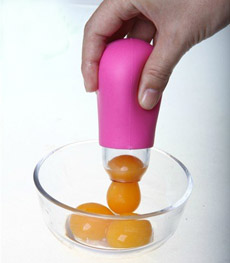TIP OF THE DAY: 5 Ways To Separate Eggs
 A conventional egg separator (strainer). Photo courtesy Oxo. |
Everyone has a technique to separate eggs. We’ve tried five:
1. Hand Method. Crack the egg and pour it into the palm of your hand; let the whites drain through your fingers (this was probably the original technique). It’s a great technique to know if you can’t find the egg separator! If you don’t like the idea of using your hands, you can use a slotted spoon; but you’ll probably need an assistant to hold the spoon. 2. Shell Transfer Method. You’ve seen chefs do this: cracking the egg, separating the shell and pouring the yolk back and forth between the halves as the whites drain into a bowl. It’s considered the “professional” way; with practice, anyone can do it. Here’s a video. 3. Funnel Method. Stand a large funnel up in a cup and crack the egg. The white will slip through. 4. Egg Separator Method. This is the one we use, relying on a gadget that allows the white to easily strain through into a bowl. This one from OXO can also clip to the rim of a mixing bowl. Here’s a video. |
|
|
5. Plastic Bottle Method. A video circulating the Internet in fun engendered today’s tip. Squeeze some of the air from a clean plastic water bottle or soft drink bottle. Crack the egg in a bowl and, squeezing the bottle slightly, place mouth of the bottle on top of the yolk. Slowly release your grip; the air pressure will push the yolk into the bottle. You can also buy small, attractive yolk extractor (photo at right) that does the same thing.
EGG SEPARATING TIPS Buying |
 The newest egg separating device: a suction cup. Photo courtesy Niceshop. |
|
|
Using The Eggs
|
||


